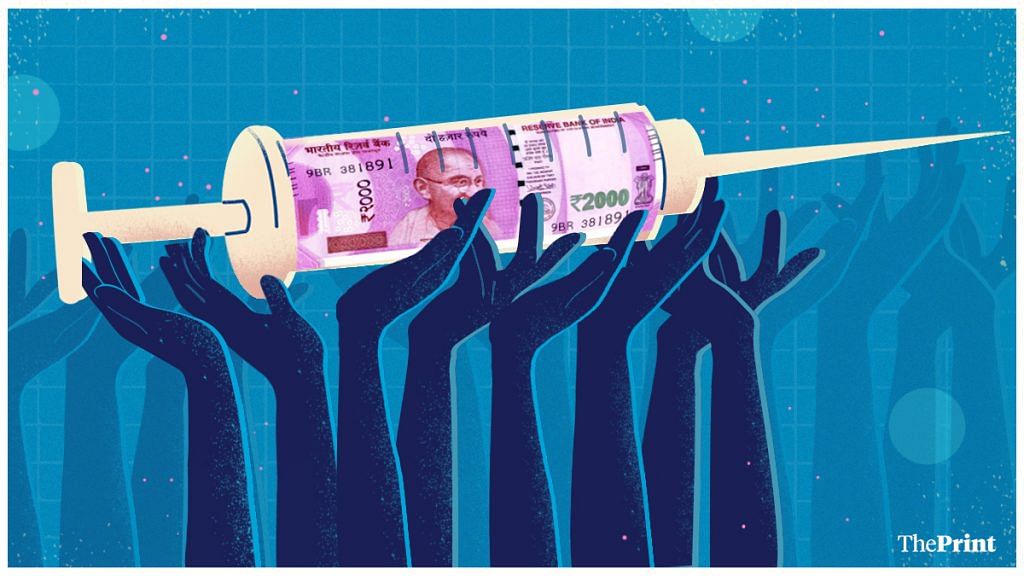The GDP numbers released this week showed that the Indian economy was on the path of recovery before the second wave of the Covid-19 pandemic hit the country.
Many high frequency indicators reflecting consumption and investment demand showed deterioration in the months of April and May, when the second wave hit. Now they are showing some improvement.
But the pick-up in demand will depend on how fast we are able to vaccinate the population. The temptation to allow fully normal economic and social activity before the population has protection from the virus could push up cases again and derail the slight improvements that we are seeing.
With a decline in the number of new Covid cases and gradual unlocking announced by a few states, demand will pick up in the next few months. Some weekly indicators are already signalling a pick-up in economic activity and demand over the last two weeks.
The trajectory of demand revival will depend on the pace of vaccination and observation of Covid-appropriate behaviour by people.
Also read: Modi govt needs a Covid cushion. RBI must transfer more of its surplus funds
What the GDP numbers say
The Indian economy grew at 1.6 per cent of GDP in the fourth quarter of 2020-21 before the second wave of the pandemic struck. For the full year, GDP contracted by 7.3 per cent. This was mildly better than the earlier estimates of an 8 per cent contraction.
The recovery in GDP was driven by a sharp recovery in the manufacturing and construction sector. Projects that were stuck during the lockdown were getting revived during the subsequent quarters. On the spending side, private consumption also recovered after a 26 per cent decline in the first quarter (April-June).
The Covid induced lockdown led to a spike in household financial savings to 21 per cent of GDP in the first quarter of last fiscal. In absolute terms, the household financial savings rose to Rs 8.1 trillion. This number was Rs 3.8 trillion in the year-ago period. The household financial savings fell substantially to Rs 4.9 trillion (10.4 per cent of GDP) in the second quarter. This is likely to have been caused both by higher consumption and lower income.
With the gradual opening of the economy and resumption of economic activity, households switched from “essentials only” consumption to discretionary consumption. Private final consumption expenditure increased from Rs 22 trillion in the first quarter of 2020-21 to Rs 33.6 trillion in the fourth quarter.
The second wave of the pandemic adversely impacted economic activity and consumption in April and May this year. A key indicator of manufacturing sector, the Purchasing Managers’ Index (PMI) moderated to 50.8 in May compared with 55.5 in April.
The services sector PMI has also seen a contraction in May. Other indicators like fuel demand, car sales, e-way bill generation also slowed down considerably in April and May.
However, the peak of the second Covid wave appears to have been crossed since the second half of May. The Covid cases are gradually coming down with nearly half of India reporting less than 5 per cent positivity rate.
Also read: India’s car sales could take a year to return to pre-Covid levels, Mahindra & Mahindra says
Signs of recovery
Amid declining trend of Covid cases, the economy is showing some early signs of getting back on track. The weekly employment showed a mild uptick from 33.58 per cent to 34.22 per cent for the week ending 30 May.
Other weekly economic indicators such as power generation, mobility indicators and traffic emissions are slowly witnessing an improvement over the last two weeks. There are also early indications of migrant workers returning to cities as the pace of Covid infections slows.
Some states have begun easing curbs, others have extended restrictions well into June. While exit from lockdowns is expected to be gradual, normalisation in economic activity is likely to gather momentum from the second half of the current year.
Rural demand held up during the first wave of the pandemic, but the severity of the second wave has hit the villages harder this time. The government is reportedly considering extending and re-launching some rural relief schemes it announced during the first wave.
These could include extension of cash and in-kind benefits, relief to unorganised sector workers and renewal of EPF subsidy. These measures could help improve consumption demand in rural areas.
The Emergency Credit Line Guarantee Scheme has been tweaked to allow more sectors to tide over liquidity crunch.
The Reserve Bank of India in its upcoming June monetary policy committee meeting could announce additional steps to boost credit to sectors adversely affected by the pandemic.
While these measures will provide some relief, the primary effect will come from improvement in protection of the population. Experience of advanced economies shows that as a significant mass of population is vaccinated, economic activity rebounds and private consumption picks up faster than anticipated.
As the government aims to target one crore vaccinations per day, the risk of infections is likely to be contained. This is likely to lift consumer sentiments and propel demand in the coming months. A durable revival in consumption would drive recovery in investments as businesses grapple with excess capacity.
Ila Patnaik is an economist and a professor at National Institute of Public Finance and Policy.
Radhika Pandey is a consultant at NIPFP.
Views are personal.
Also read: Covid, lower rates push corporate tax collections below personal tax for first time in years
